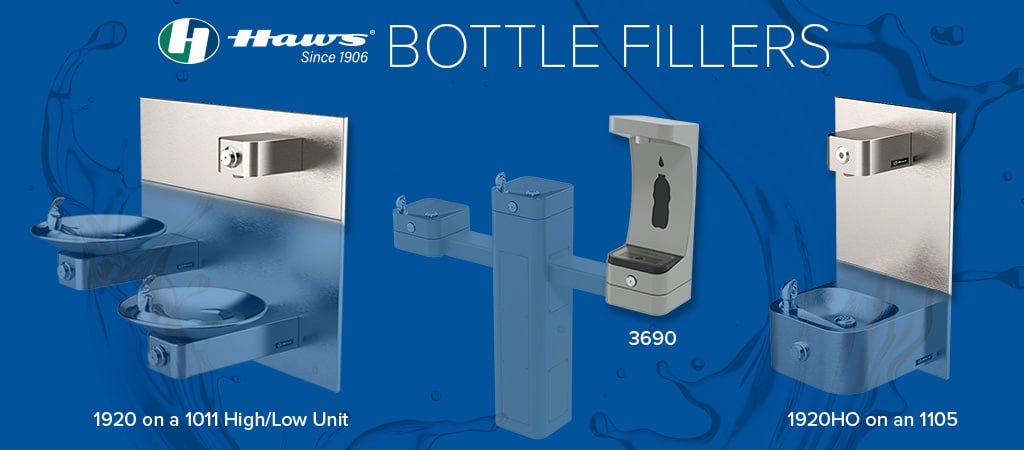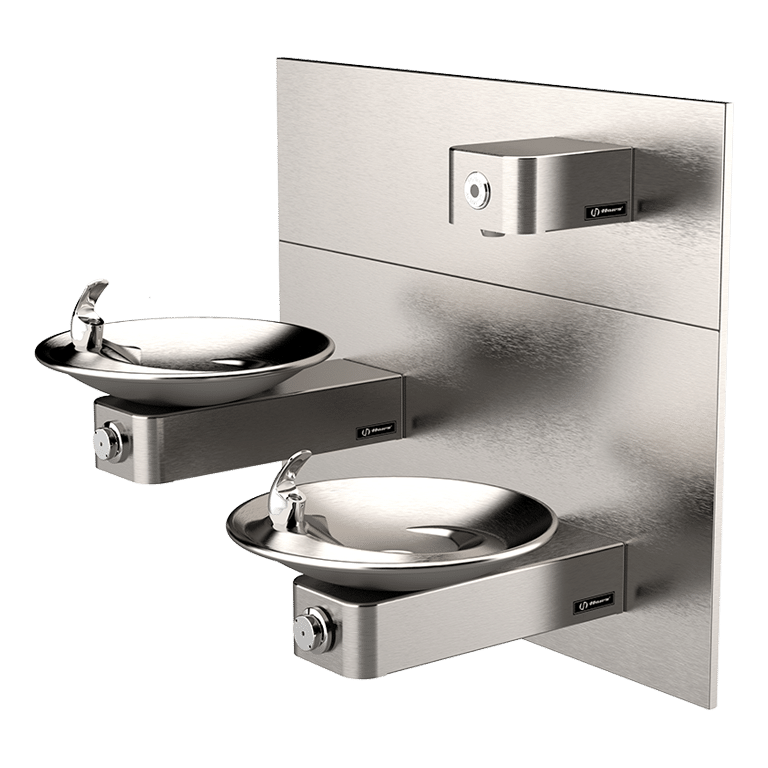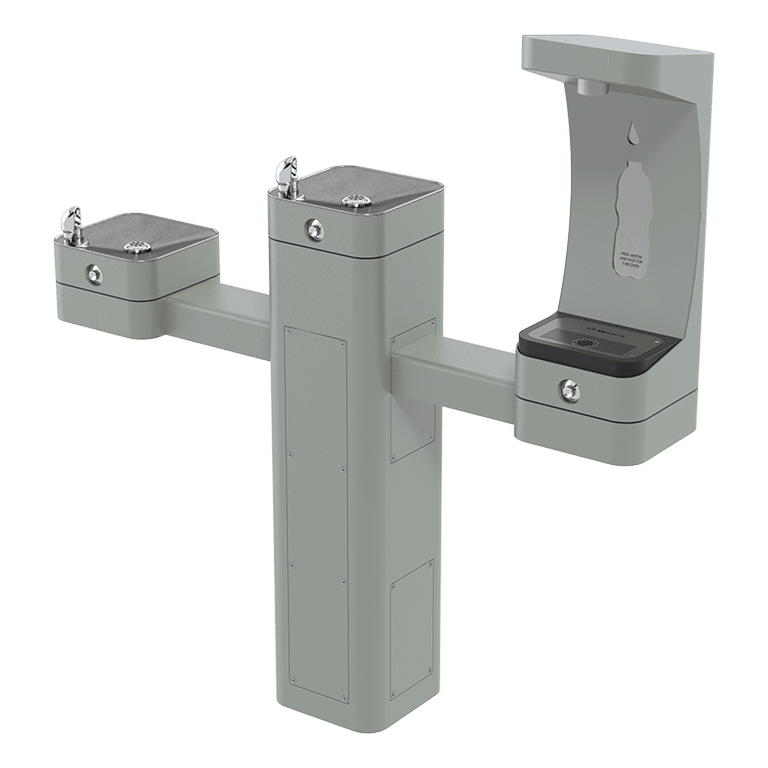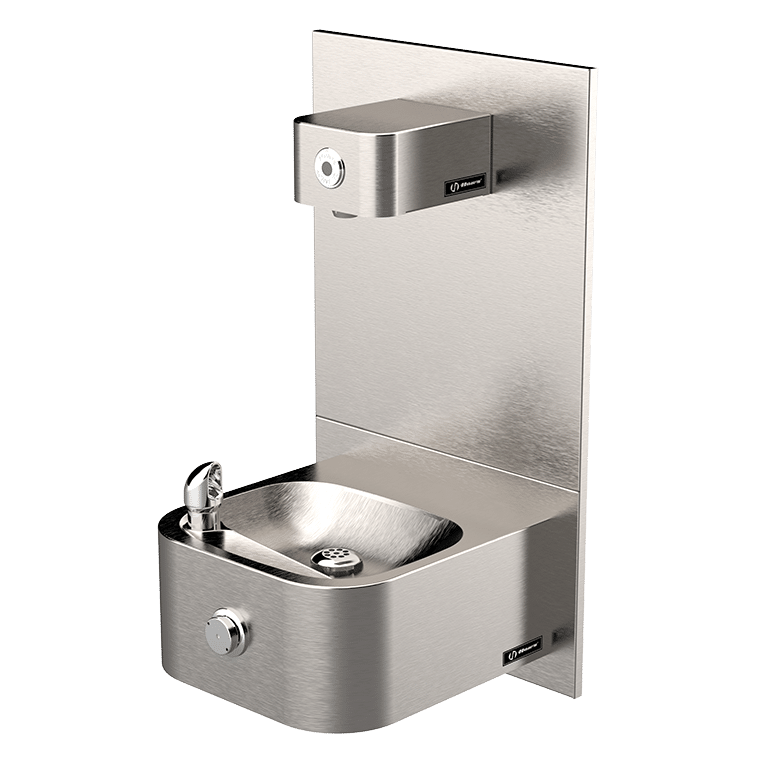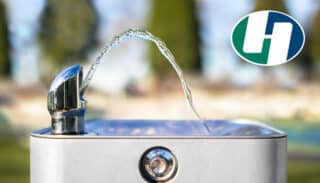How To Prepare Your Haws Outdoor Fountains for Winter During cold seasons, it is important that outdoor drinking fountains and bottle fillers are equipped for the potentially harsh winter weather. Many drinking fountains and bottle fillers are designed to withstand extreme climate conditions from an external durability standpoint, yet it is pertinent to ensure internal waterways do not freeze and create damage.
If you have an outdoor drinking fountain and/or bottle filler that has a bury valve installed below the frost line and a freeze-resistant push button, or an outdoor wall-mounted fountain with a freeze valve box and waterways inside of the building (kept at above 50°F [10°C]), then the equipment does not require any additional maintenance or preparation for winter conditions and can be left on for use throughout all seasons.
Any hydration products installed in areas that reach freezing conditions should be inspected for freeze-resistant components. Check the owner’s manual for component details. If it is determined that the equipment is not freeze-resistant by design, then follow the steps outlined below to winterize your outdoor hydration equipment.
Winterizing Your Haws Drinking Fountain or Bottle Filler
All Haws drinking fountains and bottle fillers use a patented push button activation valve (5874PB/5874PBF) with front access for adjusting stream height, and for replacing the cartridge by use of a simple spanner wrench. This allows for easier access and maintenance.
- STEP 1: Turn off water via the shutoff or on/off valve
- STEP 2: Disconnect supply line tubing from the shutoff valve at the lowest point and let water drain from the tubing
- STEP 3: Remove the cartridge from the push button valve
- A. Remove button using the provided spanner wrench. Button must be rotated so spanner wrench holes line up. Twist off push button.
- B. Remove the cartridge retaining nut using the spanner wrench by twisting counterclockwise until the nut pops off
- C. Remove cartridge and store for reuse
- STEP 4: Thread the retaining nut back on along with the push button
For models that do not use the Haws Model 5874PB Push Button or any other questions, please call Technical Support at 800.766.5612 or [email protected].
Creating Sustainable Solutions for Hydration In the United States alone, over $100 billion is spent on bottled water each year resulting in over 50 billion plastic bottles tossed in the trash can. That equates to 2.5 million plastic bottles thrown away per 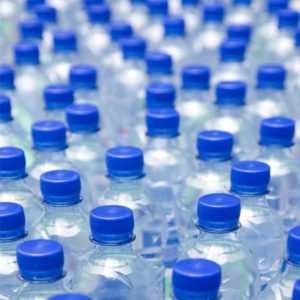 hour and 80% end up in landfills. Organizations around the globe are responding to the overwhelming financial, social, and environmental costs of bottled water consumption and disposal by providing convenient and cost-effective hydration solutions in and around their facilities. Airports, hospitals, schools and many other organizations are improving their sustainability efforts and reducing bottled water waste by upgrading to bottle filling stations such as the Hydration by Haws™. These bottle fillers help lower carbon footprints by reducing waste associated with single-use bottles and promoting the use of refillable bottles.
hour and 80% end up in landfills. Organizations around the globe are responding to the overwhelming financial, social, and environmental costs of bottled water consumption and disposal by providing convenient and cost-effective hydration solutions in and around their facilities. Airports, hospitals, schools and many other organizations are improving their sustainability efforts and reducing bottled water waste by upgrading to bottle filling stations such as the Hydration by Haws™. These bottle fillers help lower carbon footprints by reducing waste associated with single-use bottles and promoting the use of refillable bottles.
Hydration By Haws™ bottle filler benefits and options
The benefits of bottle filling stations are endless and offer the perfect solution to satisfy the growing demand for accessible, on-the-go water alternatives. With their hygienic, hands-free activation and ADA compliance, the Hydration By Haws™ bottle filler is an ideal upgrade from traditional drinking fountains to deliver clean, filtered water from standard tap lines. The multiple product options transform regular tap water into filtered drinking water by using a certified advanced filtration system. Hydration By Haws™ water dispensers offer users the benefits of clean filtered water away-from-home without the waste and cost of bottled water. One unit can reduce as many as 36,000 standard 16.9 oz bottles each year. Surface wall-mount (Model 2000SMS) or recessed mount (Model 2000S) configurations are available with custom branded logo options if preferred.
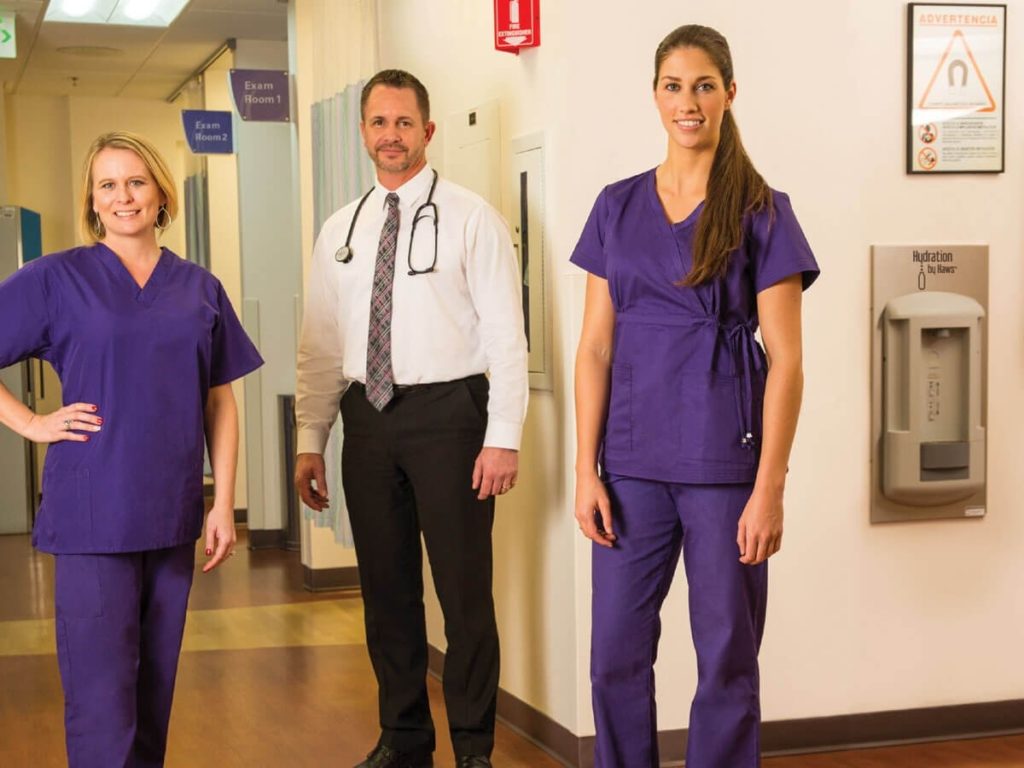
Bottle Filler Fundraising Program
The demand for convenient access to clean and cost-effective drinking water is increasing and Haws® responded by creating the Hydration By Haws™ Bottle Filler Fundraising Program. The program encourages everyone to drink more water by financing bottle filler installation costs with the proceeds raised from the sales of custom branded Nalgene® bottles. The unique fundraising program is a way to bring a hydration solution to any facility with no upfront costs, minimal set up, and the potential to keep additional profits. Find out more about this program and how you can join Haws in support of creating sustainable solutions for hydration by visiting the Hydration By Haws™ website at: www.hawshydration.com.

Make Public Drinking Water Fountains Great Again
By Rapichan Phurisamban and Peter Gleick
In February of 2017, the Pacific Institute released a white paper entitled Drinking Fountains and Public Health: Improving National Infrastructure to Rebuild Trust and Ensure Access, which highlighted the limited evidence of a link between illness and disease outbreaks and drinking fountains. The report found that most problems could be traced to contamination from poor cleaning and maintenance or old water infrastructure in buildings, and called for comprehensive testing of drinking fountains, implementation of standard protocols for fountain maintenance, and a nationwide effort to replace old water infrastructure, which can be the source of lead and other contaminants.
One aspect of efforts to expand access to fountains is to take a look at current drinking fountain technology and identify features that can help ensure their quality, convenience, and reliability. Ultimately, these features can help increase public confidence and access to high quality and affordable tap water.
A gallon of tap water from typical municipal water systems costs about half a cent, making drinking fountains the cheapest hydration source available in public spaces (and of course, almost all public fountains are completely free to the user). This cost may increase somewhat depending on the purchase, installation, and maintenance costs for each drinking fountain, but it remains far cheaper than the cost of bottled water, which typically ranges from $1 to $5 per gallon, or about 200 to 1,000 times more than tap water. (High-end bottled waters can be even far more costly.) These costs do not include the environmental costs of the bottled water industry.
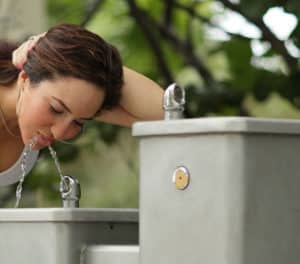 With many useful features that increase water quality and convenience, drinking fountains need no longer be the forgotten relics of the past. Cities, park districts, schools, hospitals, and other entities managing public spaces can offer fountains with many available options, including vandal resistance, freeze resistance, refrigeration, bottle filling, and filtration. Josselyn Ivanov provides a useful infographic of drinking fountain typologies, some of which are described below.
With many useful features that increase water quality and convenience, drinking fountains need no longer be the forgotten relics of the past. Cities, park districts, schools, hospitals, and other entities managing public spaces can offer fountains with many available options, including vandal resistance, freeze resistance, refrigeration, bottle filling, and filtration. Josselyn Ivanov provides a useful infographic of drinking fountain typologies, some of which are described below.
Drinking fountains located outside will need to include features to help weather the elements, such as exposed aggregate finishes to prevent corrosion. Extremely durable cast iron fountains can withstand harsh weather, but are not appropriate for beach settings as they are prone to rusting when exposed to a constant high-moisture environment. Stainless steel fountains are more suitable in such cases; in fact, they are one of the most popular fountain types due to minimal maintenance needs and low cost. Vandal-resistant fountains are a great fit for high-traffic areas as they are equipped with heavy-duty parts such as galvanized frames and steel cabinets, which protect against damage and wear. In cold regions, a freeze-resistant feature allows fountains to continue to function by preventing damage from pipe freezing and breakage. (These units must be connected to waterlines buried below the frost line in order to prevent the incoming water from freezing.)
Other fountain features can be added to cater to users’ needs. Fountain bubblers (or spouts) vary from the very basic, such as a spigot, to the much more advanced. The most common is the arc bubbler, which is equipped with a mouth guard to prevent direct contact.
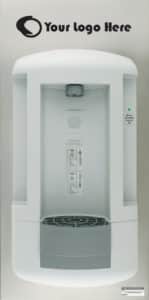 The most notable improvement in drinking fountains in recent years has been the bottle filling option. The demand for bottle filling stations or bottle filler attachments increased significantly between 2010 and 2015 due to the proliferation of refillable bottles, the ease of use of these stations, and less perceived risk of contamination. At these stations, users can rapidly fill up their personal bottles, and then the water will automatically shut off to prevent waste. Bottle fillers can be installed as standalone stations, as attachments to existing fountains, or as models that come with a drinking fountain. Many of these bottle filling stations include a digital display showing the number of disposable plastic bottles saved from landfills. The cost of a bottle filling station can range from as low as $500 per unit for a retrofit kit (an attachment) to over $1,700 for a standalone freestanding model.
The most notable improvement in drinking fountains in recent years has been the bottle filling option. The demand for bottle filling stations or bottle filler attachments increased significantly between 2010 and 2015 due to the proliferation of refillable bottles, the ease of use of these stations, and less perceived risk of contamination. At these stations, users can rapidly fill up their personal bottles, and then the water will automatically shut off to prevent waste. Bottle fillers can be installed as standalone stations, as attachments to existing fountains, or as models that come with a drinking fountain. Many of these bottle filling stations include a digital display showing the number of disposable plastic bottles saved from landfills. The cost of a bottle filling station can range from as low as $500 per unit for a retrofit kit (an attachment) to over $1,700 for a standalone freestanding model.
Water chilling is another feature that makes modern fountains attractive to users. Chilling is typically available for indoor units where they can be connected to an electrical supply. Some fountains have built-in chillers, but existing non-refrigerated fountains can also be retrofitted with remote chillers. Alternatively, ice-chilled models or drinking fountains equipped with solar power systems can be used in areas that lack access to a power supply. Most fountains can dispense up to 6.6 gallons of chilled water per hour, but in high-traffic areas, a fountain should be able to dispense at least eight gallons of chilled water per hour.
With the Flint water crisis raising awareness of potential lead contamination in tap water, the installation of filters can reduce risks in contaminated fountains until aging pipes, lead solders, and other sources of contamination can be effectively removed. There are many different types of filters, the most common being activated carbon, which may be integrated with other filter media to increase filtration efficacy. The cost of carbon filters ranges from $90 to $160 per unit, depending on filtration capacity and effectiveness, and filters must be replaced according to the manufacturer’s maintenance schedule, typically once or more each year depending on use.
In addition to carbon filters, reverse osmosis (RO) is an advanced filtration process that is also used by desalination plants. The process involves pre-screening the water to remove particles that can damage the RO membrane and then forcing water through a semi-permeable membrane under high pressure to filter out salts and other impurities. The finished water is then treated to increase the pH level and reduce the corrosiveness of the water. Replacement of RO membranes may be done every two to four years, but pre- and post-filters may need replacement every six to 12 months. Reverse osmosis is an energy-intensive and costly process that uses approximately three gallons of water for every gallon of filtered water produced. It is appropriate for removing contaminants that cannot be effectively removed by carbon filters, such as arsenic, hexavalent chromium, nitrate, and perchlorate. Other methods for removing contaminants include ceramic filters, distillers, and UV light units used to disinfect water. Since filters add to the cost of water fountains, water quality tests should be done before making any filter investments to both ensure that filters are needed and to identify the most appropriate type of filter to install.
Drinking fountains must comply with the NSF/ANSI 61 Standard, which regulates the levels of contaminants, including lead, that can leach from the fountain unit into the water. Most publicly accessible spaces that provide drinking fountains are also required to meet standards specified by the American with Disabilities Act (ADA). These standards pertain to fountain installation, location, and other specifications (e.g., water pressure) that aim to provide the greatest access to the disabled.
More effort is needed to improve access to affordable and safe drinking water at the national, state, and local levels. While we push for the broad upgrade of water infrastructure, we must also engage with cities, park districts, schools, and other institutions to rebuild public confidence in drinking fountains.
As we move toward better public drinking water access, whether installing new fountains or replacing old ones, we should strive to use the most appropriate fountain designs in order to effectively provide high quality and affordable tap water to all who need it.
[via Huffpost]
Reduce Plastic Waste by Adding a Bottle Filler to a Drinking Fountain
Facts & Solutions: Lead in Drinking Water As recently reported in multiple media outlets, high levels of lead are tainting water systems across our country. Here are some data points and facts we have collected to help summarize the issues and challenges facilities and homes are facing:
- The EPA’s national testing “action level” for lead in water is 15 parts per billion.
- A national EPA analysis conducted between 2012 and 2015 showed 350 schools and day-care centers failed lead tests a total of 470 times. [1]
- Flint Water Study sampled 252 homes in Flint, Michigan and results showed that 40% of samples were over 5 parts per billion (ppb). Flint’s 90th’ile lead value is 25 ppb in that survey. [2]
- Newark, NJ collected 2,067 samples from school buildings between 2012 and 2015 with 12% above the EPA “action level.” With results ranging from 16 to 558 ppb.[3]
- The EPA estimates that about 90,000 public schools and half a million child-care facilities are not regulated under the Safe Drinking Water Act because they depend on water sources such as municipal utilities who are expected to test their own water.[4]

- EPA recommends anyone concerned with lead should only consume filtered or bottled water (washing hands and bathing with unfiltered water is ok). Filtered water is a safe option only if the filter is certified to remove lead and it is replaced regularly. [5]
- EPA recommends using an NSF-certified water filter to remove lead. [6]
With many factors influencing water safety levels, we wanted to highlight some of the safety features of our bottle fillers and their certifications for those looking for solutions.
- Brita® Hydration Stations® are certified to NSF International 53 to remove 99% percent of lead and 99.9% of cysts from tap water that has a lead concentration of 150 parts per billion. [7]
- Point-of-Use bottleless units are designed for smaller amounts of drinking water and offer a 1,500-gallon capacity certified Brita® professional filter.
- Wall unit bottle fillers are designed for larger consumption rates and offer a 2,500 gallon capacity certified Brita® professional filter.
[1] http://www.usatoday.com/story/news/nation/2016/03/17/drinking-water-lead-schools-day-cares/81220916/
[2] http://flintwaterstudy.org/2015/09/our-sampling-of-252-homes-demonstrates-a-high-lead-in-water-risk-flint-should-be-failing-to-meet-the-epa-lead-and-copper-rule/
[3] http://www.nj.com/essex/index.ssf/2016/03/lead_in_newark_schools_water_dates_back_to_at_leas.html
[4] http://www.usatoday.com/story/news/nation/2016/03/17/drinking-water-lead-schools-day-cares/81220916/
[5] https://www.epa.gov/flint
[6] https://www.epa.gov/flint
[7] http://www.abc12.com/home/headlines/People-voice-their-concerns-about-Brita-filters–330995452.html?device=phone&c=y
Brita Hydration Station Recognized at NAMA One Show The Brita® Hydration Station® booth at the NAMA One Show in November received some recognition in the February issue of Vending Times Magazine.
“Brita Professional’s Matt DeShon showcases Brita Hydration Station, offered in several floor-standing and countertop configurations. The model 2520 (pictured here) boasts a clean and professional design that provides a dependable, low-maintenance hot and cold option for basic filtration needs. Visit britahydrationstation.com.”
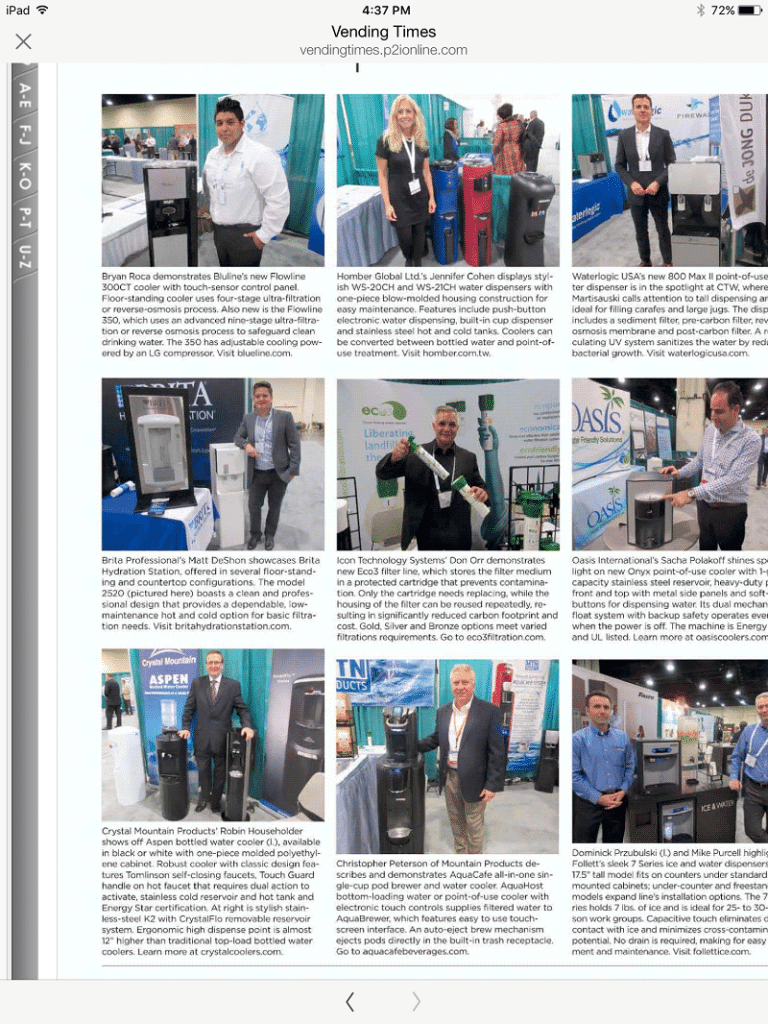
Visit BritaHydrationStation.com to learn more about the Brita® product family and how you can provide Brita® filtered water to your office, school, or facility.
For a limited time, use code “TOUCH-FREE” for $150 off wall mount bottle fillers.
Join us at IFMA 2015 – Booth #339 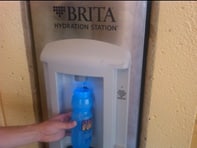
Join us at the International Facility Management Association (IFMA) World Workplace Conference and Expo, October 7-8, 2015 in Denver, CO.
IFMA’s World Workplace is a hands-on, interactive learning and networking event for professionals who support all aspects of the work environment.
Stop by booth #339 to learn more about the Brita® Professional line from the latest bottle fillers to the newest efficient water coolers. Present a copy of this blog post at the booth, and you will receive a free water bottle while supplies last.
Visit our website to learn more about the Brita® Hydration Station® today.
We look forward to seeing you there!
Download the Brita® Hydration Station® brochure now.
View the Brita® Hydration Station® overview video.

 hour and
hour and 



